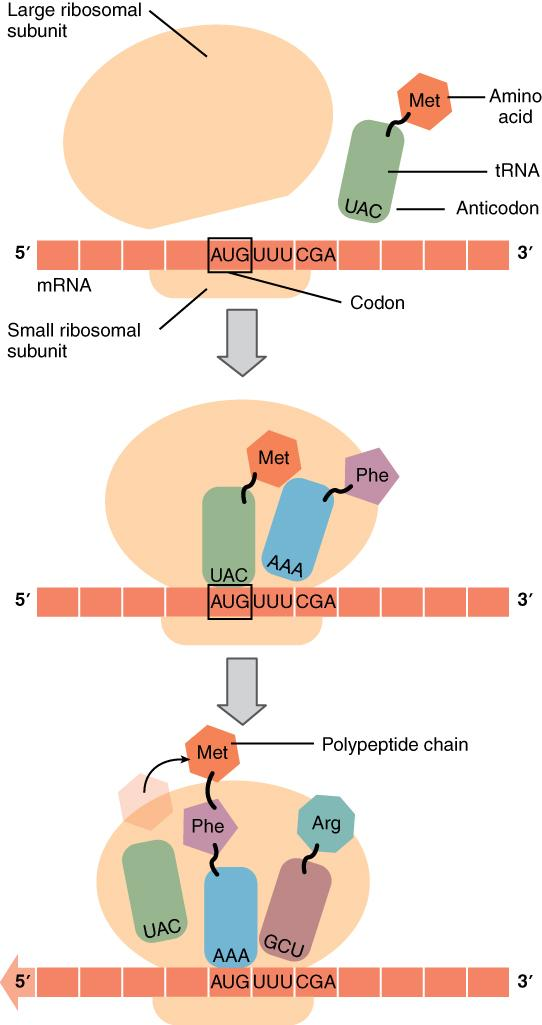
With which part the mRNA should be bound to initiate the translation?
A. The smaller ribosomal sub-unit
B. The larger ribosomal sub-unit
C. The whole ribosome
D. No such specificity exists.
Answer
219.9k+ views
Hint: mRNA (messenger ribonucleic acid) is a variety of the RNA (Ribonucleic acid) which is required in the living being for the formation of protein.
Complete step by step answer:
RNA termed ribonucleic acid is a nucleic acid that is present in the living thing cells that has some similarity with the DNA (Deoxy-ribonucleic acid). RNA is a single-stranded backbone-like structure having alternating phosphate groups and sugar ribose whereas in the DNA, the alternating deoxy-ribose group is found in repetitions. The bases attached to the sugar in nucleic acid- are Adenine(A), Uracil(U), Cytosine(C), and Guanine(G).
The different types of RNA present in the living being are rRNA, tRNA, and mRNA.
rRNA: Ribosomal RNA is used to synthesise organelle known as ribosomes which are exported to the cytoplasm to help translate the information. The rRNA molecules are synthesised in an organelle of the nucleus of a cell called the nucleolus.
tRNA: Transfer ribonucleic acid is a type of molecule required to decode the mRNA in protein. Its specific function is to synthesise a protein from an mRNA molecule.
mRNA: Messenger RNA, a blueprint of the protein which helps synthesise that protein. The transcription process creates mRNA where an enzyme, RNA polymerase, gets converted into primary transcript mRNA or pre-mRNA.
Proteins are synthesised by the ribosome which is present in the nucleolus. The ribosome consists of about 80 different proteins with structural RNA. When the protein is not in an active or inactive state, it consists of the 2 sub-unit in which one is larger and the other is a small sub-unit.

Image: Diagrammatic representation of process of Translation
Therefore, correct option to this question is A
Note: RRNA (Ribonucleic acid) is quite similar to DNA (Deoxyribonucleic acid), the difference is the positioning of the groups. DNA consists of the blueprint called gene and the RNA converts that blueprint into protein.
Complete step by step answer:
RNA termed ribonucleic acid is a nucleic acid that is present in the living thing cells that has some similarity with the DNA (Deoxy-ribonucleic acid). RNA is a single-stranded backbone-like structure having alternating phosphate groups and sugar ribose whereas in the DNA, the alternating deoxy-ribose group is found in repetitions. The bases attached to the sugar in nucleic acid- are Adenine(A), Uracil(U), Cytosine(C), and Guanine(G).
The different types of RNA present in the living being are rRNA, tRNA, and mRNA.
rRNA: Ribosomal RNA is used to synthesise organelle known as ribosomes which are exported to the cytoplasm to help translate the information. The rRNA molecules are synthesised in an organelle of the nucleus of a cell called the nucleolus.
tRNA: Transfer ribonucleic acid is a type of molecule required to decode the mRNA in protein. Its specific function is to synthesise a protein from an mRNA molecule.
mRNA: Messenger RNA, a blueprint of the protein which helps synthesise that protein. The transcription process creates mRNA where an enzyme, RNA polymerase, gets converted into primary transcript mRNA or pre-mRNA.
Proteins are synthesised by the ribosome which is present in the nucleolus. The ribosome consists of about 80 different proteins with structural RNA. When the protein is not in an active or inactive state, it consists of the 2 sub-unit in which one is larger and the other is a small sub-unit.

Image: Diagrammatic representation of process of Translation
Therefore, correct option to this question is A
Note: RRNA (Ribonucleic acid) is quite similar to DNA (Deoxyribonucleic acid), the difference is the positioning of the groups. DNA consists of the blueprint called gene and the RNA converts that blueprint into protein.
Recently Updated Pages
JEE Nuclear Chemistry Important Concepts and Tips for Exam Preparation

JEE Main College Predictor 2024: Find your college with JEE Main Score

Chemical Equilibrium – Introduction, Types, Factors and FAQs

JEE Main 2024 (January 25 Shift 2) Maths Question Paper with Solutions [PDF]

The Living World - Role of Different Substances and Taxonomic Categories

JEE Phenols Important Concepts and Tips for Exam Preparation

Trending doubts
Exothermic Reactions: Real-Life Examples, Equations, and Uses

Understanding Newton’s Laws of Motion

JEE Main 2026 Syllabus Updated for Physics, Chemistry and Mathematics

Understanding Uniform Acceleration in Physics

Difference Between Molecular Mass and Molar Mass for JEE Main 2026

Fajans Rule in Chemistry: Concept, Law & Importance

Other Pages
NCERT Solutions For Class 12 Biology Chapter 12 Ecosystem - 2025-26

NCERT Solutions for Class 12 Biology Chapter 9 Biotechnology Principles And Processes 2025-26

NCERT Solutions for Class 12 Biology Chapter 11 Organisms And Populations 2025-26

Class 12 CBSE Biology Sample Paper - Set 7 Preparation

CBSE Class 12 Biology Question Paper Set 2 (57/1/2) 2025: PDF, Solutions & Marking Scheme

Devuthani Ekadashi 2025: Correct Date, Shubh Muhurat, Parana Time & Puja Vidhi




